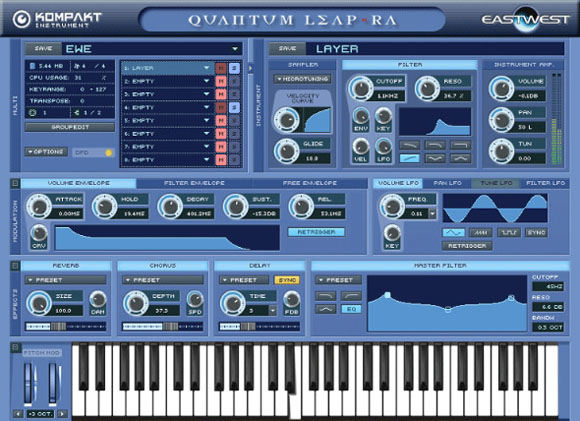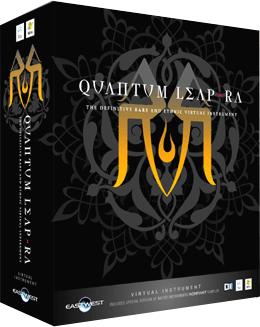Film and video scoring aficionados out there, listen up. CDM’s W. Brent Latta takes on Quantum Leap RA from East West, a massive library of sampled world/ethnic instruments. As usual, it’s not just about the product itself: Brent offers some insight into music-making using this tool, and shares a really gorgeous melody he created on the included Bulgarian duduk. Truly scary that you can get sound like this out of a computer. Read on . . . -PK

One of the things I love about the rapid pace of technological advancements in the audio industry is that I am always learning: a new keyboard shortcut here, a new way to use automation there, a new modulation routing to yield a new sonic treat. In this sense, my logical and rational brain is always being stretched. But this has always been a double-edged sword for me, because while I�m always learning new things and new ways to use the tools I�m given, that is time that could be spent honing my purely musical skills � practicing scales, studying modes, experimenting with new meters, or working with a new melody. In this sense, my creative brain is always left wanting more. I�ve always thought that having a real piano in my studio would be the simplest solution � the sheer immediacy of the instrument and the relationship a player has to it provides the perfect marriage of the brain hemispheres. Unfortunately my current space doesn�t allow for The Real Thing�and thus I�m forced to stay digital for the time being.
In my experience, it is rare in the world of electronic music to find an application or tool that pushes you both creatively and logically the way that an acoustic instrument can. But I am happy to say that I believe I have found just such a tool � a product, that blurs the distinction between tool and instrument and thus challenges both sides of the brain: Quantum Leap RA.

Overview
East West/Quantum Leap has been putting out astoundingly good sample collections for years, so it is no surprise that this groundbreaking library comes from the same producers who brought us EWQL Symphonic Orchestra, Stormdrum and the Drumkit From Hell. RA is the largest, most complete, and most detailed ethnic sample collection yet compiled, and producer Nick Phoenix and his team have truly outdone themselves with this library. In similar fashion to other EWQL collections of this caliber, RA is a massive 14 Gigabyte Virtual Instrument utilizing the Native Instruments Kompakt player. In its scope, RA covers a broad spectrum of instruments from all corners of the world, including Africa, the Americas, Australia, Europe, China, Japan, India, the Middle East and the Turkish Empire.
Transcending the Virtual Instrument
If you think RA sounds impressive based on the above information or the spec sheets, wait until you open up the 118 page PDF manual. It is here that I first began to realize that RA was not just another virtual instrument, but something that begins to transcend the typical sample library.
The manual � provided only in PDF format (save the trees!) � reads like an essay on World Music, providing brief overviews of each sample instrument, its origins, construction, and, most importantly, its use and capabilities in performance. What�s that you say? You�ve never seen or heard an Afro-Brazilian Berimbau? The manual not only provides a photograph, but offers a brief explanation of how the instrument is constructed and how the instrument is played. For those inexperienced with any particular instrument in this collection, this brief overview provides invaluable information as to how to accurately and realistically utilize these sounds in your projects.
In Use
RA provides a number of ways to start using each instrument out of the box. Programs are broken down into 3 basic categories: Keyswitches, Live and Elements.
For experimenting and getting a general idea of what each instrument sounds like and how it might be played, the �Live� selection is used. These are the most typical techniques and articulations for each instrument, and are designed to be very �playable� without having in-depth knowledge of the instrument or requiring a lot of tweaking.
The Elements folder contains each of the basic programs of the instrument, as well as some special FX programs if you�re looking for very unique sounds from a particular instrument. Some composers don�t like to use Keyswitches, so the Elements folder provides an alternative way to access all the sounds available for a given instrument.
For those composers who like accuracy and immediacy, however, the Keyswitch programs really show the power and versatility of this library. Each of these programs will typically contain all of the articulations available for the instrument. Through creative playing techniques or post-processing and tweaking of MIDI note data, utilization of the Keyswitch programs allows the full breadth and depth of each sampled instrument to be explored. Using the KS programs a composer can quickly move from aggressive to subtle articulations while still maintaining a flowing melodic line.
In my composing, I�ve found the KS programs to be the most useful. While I�m certain I could achieve similar results using combinations of the Live or Elements options, the immediacy of the KS programs allows for efficient line writing while exploring the full dynamic range of the instrument.
As I began to explore the depth and breadth of this library while using the KS programs, it occurred to me that I was learning as much about the capabilities of the originating instrument as I was about how to actually use and program it within my DAW of choice. As a case in point, one of the included instruments is the Japanese flute known as the Shakuhachi. You might recognize this sound from a variety of film scores, Peter Gabriel�s “Sledgehammer” or from your own collection of world music. Never having seen or played one in real life, my understanding of the instrument was quite limited � until I started exploring the keyswitches.
The number of articulations for this instrument is astounding and exploring the variety of effects is half the fun of this library. This instrument in particular has 14 different keyswitch layers, resulting in a roughly 20MB sample.
Learning to use these keyswitches effectively in composition is another matter, and a great deal of patience, trial and error, and an occasional stroke of luck is needed. While I�m certain that actual players of these instruments could easily tell when an articulation is out of place, it is entirely possible to create dramatic and very passable arrangements for a wide variety of instruments if you spend enough time. I�ve taken the time to whip up a quick demo of one of my favorite wind samples from the collection, the Duduk. Hans Zimmer made good use of this instrument when he recruited legendary Duduk player Djivan Gasparyan for the score to the film “Gladiator”. For this sample, I�ve used the Bulgarian Duduk (there are three different instruments to choose from), which is one of my favorites.
Duduk melody sound sample [MP3]
For this sample I used a variety of different keyswitches, all from the same KS patch. I added only a bit of Logic�s Space Designer reverb to give the patch some additional space. As you can plainly see, this is quite simply an astounding library.
Conclusion
Mammoth sample libraries such as RA aren�t for everyone. Many composers and producers prefer to work with loops or phrases when dealing with ethnic music. For those composers who tend to be more �from scratch�, however, it is hard to deny the value of this collection. You�d be hard pressed to find a more cohesive, expressive and extensive set of ethnic samples. You will pay a price for it, but producers who must have the highest quality and most flexibility will not balk at the price for such a collection. A library like this is particularly useful if you�re doing mock-ups for what will later become full orchestrations. With such versatile samples, your musical ideas can be expressed much more easily, even if you don�t know how to verbalize what articulation you want the musician to play. You can simply say to them, “Make it sound like this!”
There are certainly some gaps in terms of what instruments I�d personally like to see represented, but given the already huge size of this library, I�m certain that Nick Phoenix and company could easily create a RA2 and have another hit on their hands.
In short � this is quite simply one of the best sample libraries I�ve had the pleasure of using, and I highly recommend it to anyone who is looking for the absolute best quality ethnic samples short of hiring the musicians themselves.